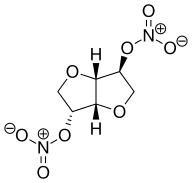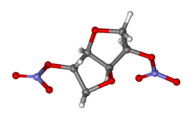Isosorbide dinitrate
Isosorbide dinitrate (ISDN) is a medication used for heart failure, esophageal spasms, and to treat and prevent chest pain from not enough blood flow to the heart.[1] It has been found to be particularly useful in heart failure due to systolic dysfunction together with hydralazine in black people.[2][1] It is taken by mouth or under the tongue.[1]
 | |
 | |
| Clinical data | |
|---|---|
| Trade names | Isordil, others[1] |
| Other names | (3R,3aS,6S,6aS)-hexahydrofuro[3,2-b]furan-3,6-diyl dinitrate |
| AHFS/Drugs.com | Monograph |
| Pregnancy category |
|
| Routes of administration | By mouth |
| ATC code | |
| Legal status | |
| Legal status |
|
| Pharmacokinetic data | |
| Bioavailability | 10–90%, average 25% |
| Metabolism | Liver |
| Elimination half-life | 1 hour |
| Excretion | Kidney |
| Identifiers | |
IUPAC name
| |
| CAS Number | |
| PubChem CID | |
| DrugBank | |
| ChemSpider | |
| UNII | |
| KEGG | |
| ChEBI | |
| ChEMBL | |
| CompTox Dashboard (EPA) | |
| ECHA InfoCard | 100.001.583 |
| Chemical and physical data | |
| Formula | C6H8N2O8 |
| Molar mass | 236.136 g/mol g·mol−1 |
| 3D model (JSmol) | |
SMILES
| |
InChI
| |
| | |
Common side effects include headache, lightheadedness with standing, and blurred vision.[1] Severe side effects include low blood pressure.[1] It is unclear if use in pregnancy is safe for the baby.[1] It should not be used together with medications within the sildenafil family.[1] ISDN is in the nitrate family of medications and works by dilating blood vessels.[1]
Isosorbide dinitrate was first written about in 1939.[3] It is on the World Health Organization's List of Essential Medicines, the most effective and safe medicines needed in a health system.[4] ISDN is available as a generic medication.[1] The wholesale cost in the developing world is about US$6.36 a month.[5] In the United States it costs less than US$25 per month.[6] A long acting form exists.[1]
Medical uses
It is used for angina, in addition to other medications for congestive heart failure, and for esophageal spasms.[1]
Long-acting nitrates can be more useful as they are generally more effective and stable in the short term.
Side effects
After long-term use for treating chronic conditions, tolerance may develop in patients, reducing its effectiveness. The mechanisms of nitrate tolerance have been thoroughly investigated in the last 30 years and several hypotheses have been proposed. These include:
- Severe allergic reactions (rash; hives; itching; difficulty breathing; tightness in the chest; swelling of the mouth, face, lips, or tongue); fainting; fast or slow heartbeat; nausea; new or worsening chest pain; vomiting.
- Impaired biotransformation of ISDN to its active principle NO (or a NO-related species)
- Neurohormonal activation, causing sympathetic activation and release of vasoconstrictors such as endothelin and angiotensin II which counteract the vasodilation induced by ISDN
- Plasma volume expansion
- The oxidative stress hypothesis (proposed by Munzel et al. in 1995)
The last hypothesis might represent a unifying hypothesis, and an ISDN-induced inappropriate production of oxygen free radicals might induce a number of abnormalities which include the ones described above. Furthermore, nitrate tolerance is shown to be associated with vascular abnormalities which have the potential to worsen patients prognosis:[7] these include endothelial and autonomic dysfunction.[8] In the short run, ISDN can cause severe headaches, necessitating analgesic (very rarely up to morphine) administration for relief of pain, as well as severe hypotension, and, in certain cases, bradycardia. This makes some physicians nervous and should prompt caution when starting nitrate administration.
Mechanism of action
Similar to other nitrites and organic nitrates, isosorbide dinitrate is converted to nitric oxide (NO), an active intermediate compound which activates the enzyme guanylate cyclase (atrial natriuretic peptide receptor A). This stimulates the synthesis of cyclic guanosine 3',5'-monophosphate (cGMP) which then activates a series of protein kinase-dependent phosphorylations in the smooth muscle cells, eventually resulting in the dephosphorylation of the myosin light chain of the smooth muscle fiber. The subsequent sequestration of calcium ions results in the relaxation of the smooth muscle cells and vasodilation.[9]
Society and culture
Isosorbide dinitrate is sold in the US under the brand names Dilatrate-SR by Schwarz and Isordil by Valeant, according to FDA Orange Book. In the United Kingdom, Argentina, and Hong Kong, a trade name of it is Isoket. It is also a component of BiDil.
References
- "Isosorbide Dinitrate/Mononitrate". The American Society of Health-System Pharmacists. Archived from the original on 21 December 2016. Retrieved 8 December 2016.
- Chavey, William E.; Bleske, Barry E.; Van Harrison, R.; Hogikyan, Robert V.; Kesterson, Sean K.; Nicklas, John M. (1 April 2008). "Pharmacologic management of heart failure caused by systolic dysfunction". American Family Physician. 77 (7): 957–964. ISSN 0002-838X. PMID 18441861.
- Fischer, Janos; Ganellin, C. Robin (2006). Analogue-based Drug Discovery. John Wiley & Sons. p. 454. ISBN 9783527607495. Archived from the original on 2016-12-20.
- "WHO Model List of Essential Medicines (19th List)" (PDF). World Health Organization. April 2015. Archived (PDF) from the original on 13 December 2016. Retrieved 8 December 2016.
- "Isosorbide Dinitrate". International Drug Price Indicator Guide. Retrieved 8 December 2016.
- Hamilton, Richart (2015). Tarascon Pocket Pharmacopoeia 2015 Deluxe Lab-Coat Edition. Jones & Bartlett Learning. p. 160. ISBN 9781284057560.
- (Nakamura et al.)
- (Gori et al.).
- Rang; et al. Pharmacology (8th ed.). Elsevier. p. 261. ISBN 978-0-7020-5362-7.